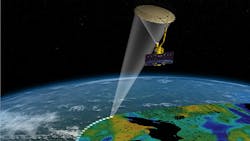In order to better understand the processes that link the earth’s water, energy, and carbon cycles, NASA’s Soil Moisture Active Passive (SMAP) spacecraft will help improve weather and climate prediction models. Developed by the Jet Propulsion Laboratory (JPL), SMAP is now fully operational for its three-year mission providing global measurements of soil moisture. SMAP is capable of taking such measurements thanks to a 20-ft. spinning mesh reflector—the largest yet to be deployed in space.
SMAP also incorporates an L-band radar and radiometer. Use of the L-band enables observations of soil moisture through moderate vegetation coverage, independent of cloud clover. Multiple polarizations enable accurate estimates with corrections made for a variety of factors, including surface roughness and Faraday rotation. The radar uses unfocused SAR processing with the range and azimuth resolutions determined by the unique antenna scan geometry at a frequency of 1.26 GHz.
The use of both active and passive instruments allows for high spatial resolution with lower soil moisture sensitivity (active), as well as higher soil moisture accuracy with coarse spatial resolution (passive). The instruments aboard SMAP spin at about 15 rpm, creating a conically scanning antenna beam that spans approximately 620 miles, and enabling total global mapping every 2-3 days. In addition to measuring soil moisture levels, SMAP will help identify frozen or thawed water. This will be used to detect changes in season length, in turn helping scientists understand how much carbon plants absorb from the atmosphere each year.
About the Author
Iliza Sokol
Associate Digital Editor
Iliza joined the Penton Media group in 2013 after graduating from the Fashion Institute of Technology with a BS in Advertising and Marketing Communications. Prior to joining the staff, she worked at NYLON Magazine and a ghostwriting firm based in New York.
